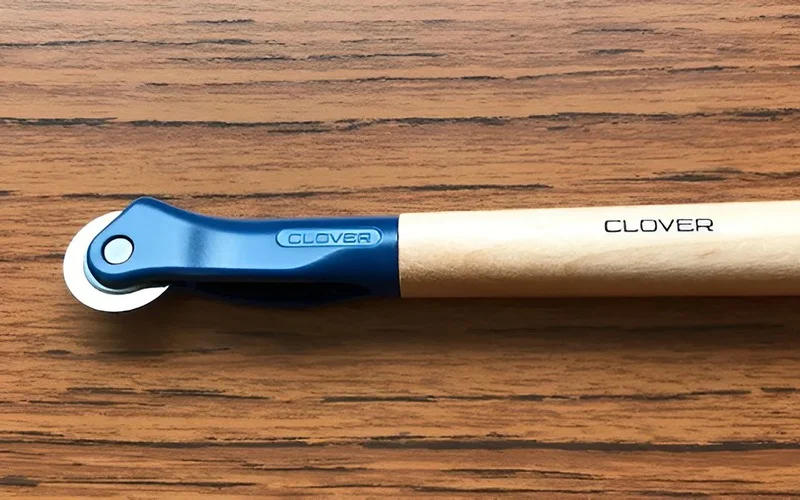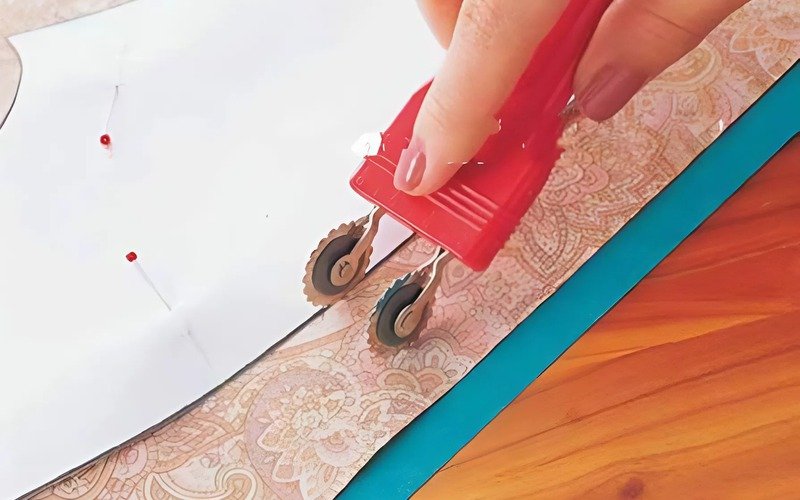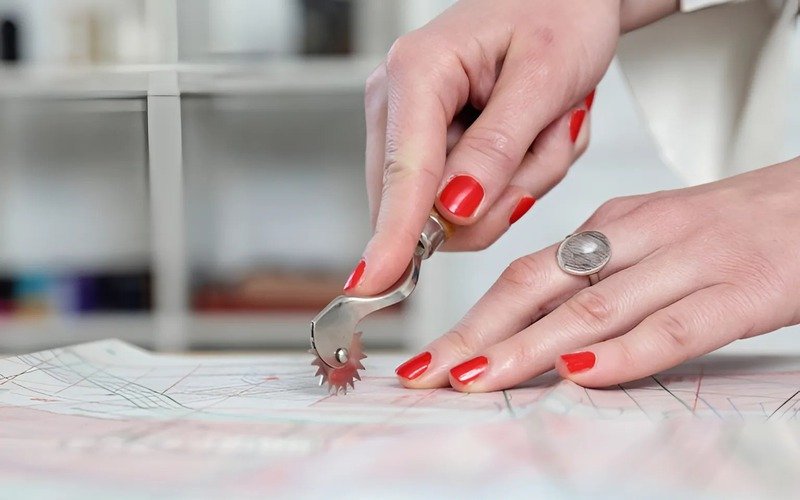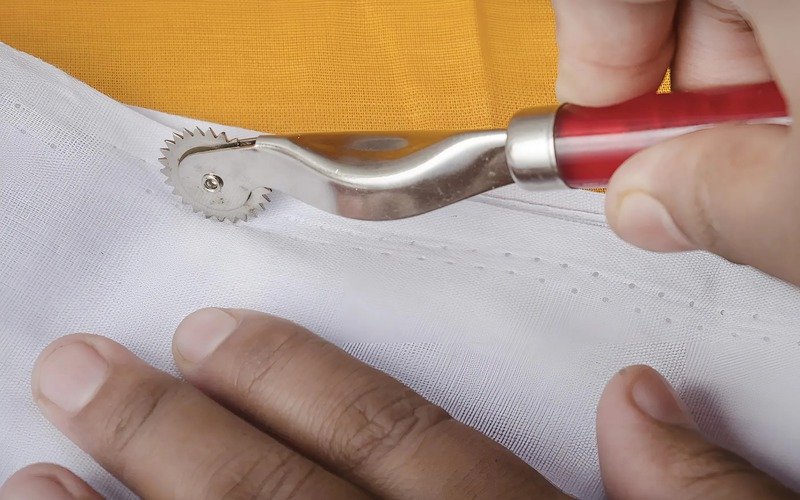What Is A Tracing Wheel? Easy Guide To This Sewing Tool
Sewing involves many useful tools. These craft supplies are key to making your projects look neat and professional. Have you ever seen a small wheel on a handle in a sewing kit and wondered what it’s for? This article will explain what a tracing wheel is, why it’s a great tool for sewing, and how to use it, all in simple terms. This guide is for anyone new to sewing or making clothes, including hobby crafters.
1. What exactly is a tracing wheel?
Understanding your tools is the first step to great sewing. The tracing wheel might look simple, but it plays a big role in creating well-made garments. Let’s break down what it is and what it does.
1.1. Simple definition
A tracing wheel, sometimes called a pattern wheel or marking wheel, is a simple sewing tool. It has a handle and a small, spinning metal wheel at one end. You might also hear it referred to as a dressmaker’s tracing wheel. It’s designed to be easy to hold and use.
1.2. Its main job: copying lines
The main job of a tracing wheel is to transfer markings from a sewing pattern onto your fabric. To do this, it’s almost always used with a special kind of paper called tracing paper (we’ll talk more about this paper later). This process is very important for accurate pattern transfer. It helps clarify the combined use of a tracing wheel and tracing paper.
1.3. Why it’s called a “tracing” wheel
It’s called a “tracing” wheel because you use it to “trace” or follow the pattern lines. As you roll the wheel along these lines, it presses down on the tracing paper. The tracing paper then transfers a mark onto your fabric below.

1.4. Other names you might hear
Sometimes, especially with older or more traditional types, a tracing wheel might be called a pounce wheel. This term is less common today but good to know.
2. Why is a tracing wheel so helpful for sewing? (Benefits)
A tracing wheel isn’t just another gadget; it offers real advantages that can improve your sewing projects, especially when you are starting out. It helps make your sewing tasks easier and your results better.
2.1. Makes copying easy and accurate
One of the biggest benefits is accuracy. A tracing wheel helps you copy important lines like darts, pleats, and seam allowance markings from the pattern to the fabric very precisely. This accuracy is very important for good pattern drafting and making sure your finished garment fits well. Accurate marks ensure all pieces match up correctly, leading to a better-fitting garment. It’s especially great for marking darts and other detailed pattern elements.
2.2. Saves time
Once you get the hang of it, using a tracing wheel can be much faster than other marking methods. Think about drawing every line with tailor’s chalk, hand-basting guidelines, or using lots of pins to define lines – a tracing wheel can speed this up.
2.3. Clear marks
When used correctly with good tracing paper, the marks made by the wheel usually show up as a clear dotted line or solid line on the fabric. These marks are generally easy to see and follow when you are sewing or cutting. This is because factors like paper quality, fabric type, and how much pressure you use can affect the marks.

2.4. Good for many fabric types
There are different types of tracing wheels available. This variety means you can often find a wheel that works well for the specific fabric marking needs of various materials. It can be used on sturdy fabrics like denim and also on more delicate fabrics like silk, if you choose the right wheel. This versatility is a big plus.
2.5. A must-have for dressmaking and pattern making
For anyone serious about dressmaking or creating their own patterns (pattern making), a tracing wheel is an essential tool. It’s a fundamental piece of garment creation tools and pattern making equipment that professionals and dedicated hobbyists rely on.
3. Different kinds of tracing wheels: choosing your helper
Not all tracing wheels are the same. Understanding the main types of tracing wheels in dressmaking will help you choose the best one for your projects and fabrics. Each type has specific features suited for different tasks.
3.1. The serrated (spiky) tracing wheel
- Description: This serrated tracing wheel, also known as a spiky tracing wheel, has an edge with pointy teeth, much like a tiny pizza cutter but with spikes.
- Best for: It’s generally best for medium to heavy weight fabrics like cotton, denim, canvas, or wool. These are fabrics where the marks need to be clearly pressed in. It creates a distinct dotted line on the fabric.
- Why: The sharp points on the wheel press firmly through the tracing paper and onto the fabric, making clear, individual marks that are easy to follow.

3.2. The smooth edge tracing wheel
- Description: This smooth edge tracing wheel has a completely smooth, non-pointy edge. Think of it like a dull knife wheel or a very thin, smooth wheel or disc.
- Best for: It’s ideal for delicate fabrics like silk, chiffon, organza, or very thin cottons. These fabrics could be snagged, punctured, or damaged by a spiky wheel. It’s also good for marking on paper patterns (like when you’re tracing a pattern onto new paper to preserve the original) or when you prefer a solid, continuous line mark (though this also depends on your tracing paper).
- Why: It’s gentle on the fabric. It won’t leave holes, pull threads, or create perforations that could weaken delicate materials. From our experience at Packlove, using a smooth edge wheel is crucial to prevent any damage on delicate fabrics like silks or chiffons, ensuring the markings are clean and the fabric integrity is maintained.

3.3. The double tracing wheel (less common for beginners)
- Description: The double tracing wheel has two wheels positioned side-by-side. Often, the distance between these wheels can be adjusted.
- Use: It’s used for marking two parallel lines at once. This is handy for tasks like marking both the cutting line and the sewing line at the same time, or for quickly adding seam allowances to a pattern that doesn’t include them.
- Note: While it’s a clever tool, it’s not usually the first one a beginner needs to buy. The serrated or smooth edge wheel is more fundamental.

4. What else do you need to use a tracing wheel?
A tracing wheel works best as part of a team. To use it effectively, you’ll need a few other key items. Having these ready will make your pattern transfer process smooth and successful.
4.1. Tracing paper (also called dressmaker’s carbon paper)
This is not the thin, see-through paper artists use for sketching. Sewing tracing paper, often called dressmaker’s carbon paper or pattern transfer paper, is special. It’s a coated paper, with one side covered in a chalky, waxy, or ink-like substance. This coating is what transfers to the fabric to make the mark for fabric marking. It comes in various colors like white, yellow, blue, and red. This is so you can choose a color that will show up well on your specific fabric but ideally won’t be too hard to remove or be permanent if not desired. This paper is crucial for understanding what is a tracing wheel and tracing paper used for together effectively.
4.2. Your sewing pattern
This is simply the paper pattern that has all the lines, symbols, and pattern markings you want to copy onto your fabric. It’s your blueprint.
4.3. Your fabric
This is the fabric you intend to sew your project with. The markings will be transferred onto this project fabric.
4.4. A protective surface (important!)
Using a protective surface is very important. You can use:
- A self-healing cutting mat (this is ideal).
- A thick piece of cardboard.
- An old stack of magazines.
- A special pattern-cutting board.
Why? The tracing wheel, especially the serrated type, presses quite hard. It could scratch, indent, or leave marks on your table or work surface if it’s not protected. MyPackLove.com always advises protecting your work surfaces to keep them in good condition and ensure your tools perform best. Using a self-healing mat is a great way to protect table surfaces.

5. How to use a tracing wheel: a super simple step-by-step guide
Now that you know what a tracing wheel is and what you need with it, let’s learn how to use a tracing wheel for sewing patterns. Follow these simple steps for accurate tracing wheel for fabric marking techniques.
5.1. Step 1: Get ready
First, set up your workspace correctly.
- Lay down your protective surface (like a cutting mat or cardboard) on a flat, hard table.
- Place your fabric on the protective surface. Usually, you place it right side up, but always check your pattern instructions for any specific advice.
- Take your tracing paper. Place it colored side down on top of the fabric, where you want the markings to appear.
- Carefully place your sewing pattern piece on top of the tracing paper. Make sure to align pattern pieces precisely as needed.
- You can use pattern weights or pins (placed outside the lines you will trace) to keep all the layers from shifting.
5.2. Step 2: Start tracing
Hold the tracing wheel much like you would hold a pen or a craft knife. This gives you good control. Apply firm, even pressure as you roll the wheel along the pattern lines that you need to transfer (like seam lines, dart lines, or pocket placements). For using a tracing wheel to transfer pattern markings effectively, steady and consistent pressure is key.

5.3. Step 3: Check your marks
Before you trace everything, carefully lift a small corner of the pattern piece and the tracing paper. Peek at the fabric underneath to check marks. Are the marks clear and easily visible?
- If marks are too light: press a bit harder or go over the line again gently.
- If marks are too heavy, smudged, or seem to be damaging the fabric (especially with a serrated wheel on delicates): try using less pressure.
This is where testing on a scrap piece of fabric first (see tips in Section 7) is very helpful and highly recommended. This helps you adjust pressure correctly.
5.4. Step 4: Continue for all markings
Once you are happy with the pressure and the clarity of the marks, continue to trace all lines and trace symbols on that pattern piece. This will complete marking for that section. Repeat for all pattern pieces as needed.
6. Quick tips for happy tracing
Here are a few quick tips to make your experience with a tracing wheel even better:
- Test first: Always, always test your tracing wheel and tracing paper on a scrap fabric piece from your actual project before marking your main pieces. This helps you see if the chosen tracing paper color shows up well, if the wheel type is right for the fabric (doesn’t damage it), how much pressure you need, and if the marks wash out as expected.
- Choose the right wheel: Remember: a serrated wheel for most medium to heavy fabrics, and a smooth edge wheel for delicates or for tracing onto paper. This helps you choose the right wheel for the job.
- Choose the right tracing paper color: Use a tracing paper color that contrasts well with your fabric so marks are easy to see. For dark fabrics, use light-colored paper (white, yellow). For light fabrics, use darker paper (blue, red). Be careful with colors that might be hard to remove or show through on very light fabrics.
- Steady pressure: Apply even and steady pressure while rolling the wheel. This creates uniform and clear lines.
- Protect your pattern: If your paper pattern is delicate or you plan to use it many times, consider tracing a copy onto sturdier paper. Then, use that sturdier copy as your master pattern with the tracing wheel to protect pattern originals.
- Work on a hard, flat surface: This provides the best support for making clear, crisp marks. A hard flat surface prevents faint or skipped lines.
7. Taking care of your tracing wheel
Tracing wheels are fairly simple sewing tools and don’t need much special attention. To care for tracing wheel tools:
- Keep it dry, especially if the wheel is metal, to prevent rust.
- Store tracing wheel tools in a way that the wheel part (especially if serrated) doesn’t get bent, chipped, or damaged. A separate compartment in a sewing box or a small cover over the wheel can help protect the wheel.
8. From tracing to treasure: finishing your handmade items
After expertly using your tracing wheel and sewing amazing handmade apparel or custom garments, think about adding that final professional touch. Making your creations truly unique and polished is a rewarding part of the process, especially for branding handmade clothing items.
At Packlove, we understand the journey of creating and the pride in handmade quality. If you’re looking to elevate your finished items, Packlove offers many ways to add that special touch of professionalism and brand identity.
- Custom woven labels (woven label – a label made by weaving threads together, like on clothing necklines): These are soft, durable, and give a truly professional, high-end feel to garments. Ideal for branding inside clothing or on accessories.
- Heat transfer labels (heat transfer label – a label applied to fabric using heat and pressure, often tagless): A great tagless option, perfect for items where comfort is key, like t-shirts or children’s wear. Easy to apply and smooth against the skin.
- Hang tags (a tag attached to a product, often displaying brand and price information): Perfect for sharing your brand story, item details, pricing, or care information in a stylish way. They add a retail-ready look.
- Care tags: Essential for providing proper garment care instructions, ensuring your handmade items last.

9. Frequently asked questions (FAQs)
Here are answers to some common questions about tracing wheels:
9.1. Can I use a tracing wheel on all types of fabric?
Mostly, yes! The key is to choose the right type of wheel for your fabric. For delicate fabrics like silk or chiffon, use a smooth edge tracing wheel to avoid any snags or damage. For most other fabrics like cotton, linen, or wool, a serrated tracing wheel usually works best. Most importantly, always, always test on scrap fabric your tracing wheel and tracing paper first before marking your actual project pieces.
9.2. What if I don’t have tracing paper?
Tracing paper (also known as dressmaker’s carbon paper) is specifically designed to work with a tracing wheel to transfer marks. The colored coating on the paper is what creates the line on your fabric. While there are other old-school marking methods like tailor’s chalk, a tracing wheel itself really needs the tracing paper to transfer its line effectively.
Without it, the wheel alone will likely just leave indentations or could potentially damage the fabric without leaving a visible colored mark.
9.3. Do the marks from a tracing wheel wash out?
This depends entirely on the type of tracing paper you use, not on the wheel itself. Some tracing papers are designed to create temporary marks that will wash out with water or fade over time, while others make more permanent marks.
Always check the packaging of your tracing paper for information on its removability. And, as always, test on fabric scrap first to see if the marks come out to your satisfaction before using it on your main project.

9.4. Is a tracing wheel expensive?
No, tracing wheels are generally very affordable. They are a small investment for such a useful and time-saving tool, and are considered one of the essential tools for beginner sewers. You can usually find them at most craft stores, fabric shops, or online.
9.5. I’m a complete beginner, do I really need a tracing wheel?
While you can technically sew without one by using other marking methods, a tracing wheel is highly recommended, even for complete beginners. It significantly helps in making the transfer of pattern markings (like seam lines, darts, pleats, and placement dots) much easier, faster, and, most importantly, more accurately than trying to do it freehand or with other sometimes more complicated methods.
This accuracy is very helpful when you’re learning to sew garments that fit well and look professional. It’s a trusted tool favored by seamstresses, fashion designers, and hobby crafters of all skill levels for good reason!
Read more:
A tracing wheel is a simple but very powerful and helpful tool for anyone who enjoys sewing. It makes copying patterns onto fabric much more accurate and often quicker, leading to better results in your projects. Like any tool, the more you use it, the more comfortable and skilled you’ll become. Happy sewing and creating your wonderful projects!
Feeling inspired to perfect your sewing projects and give your handmade creations a standout brand identity? Explore the full range of custom labels, tags, and packaging solutions at Packlove – your partner in bringing beautiful ideas to life!
If you have any questions or need advice on the best branding options for your items, don’t hesitate to Contact our friendly Packlove team for expert guidance. Don’t forget to follow Packlove on social media for more tips, inspiration, and updates on creating impactful product packaging!






















